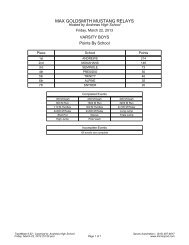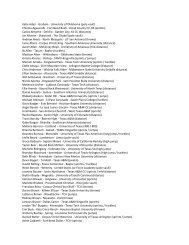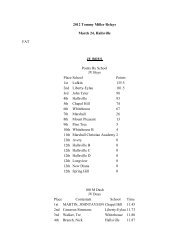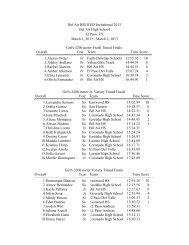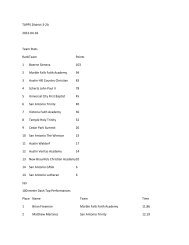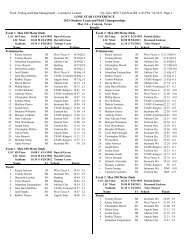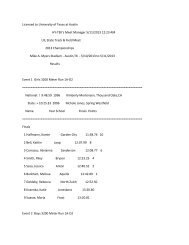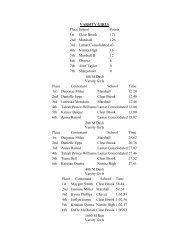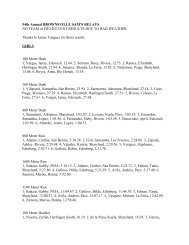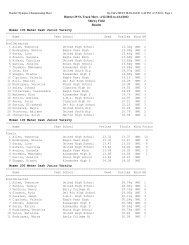1. PAGES 1-35 - Texas Track & Field Coaches Association
1. PAGES 1-35 - Texas Track & Field Coaches Association
1. PAGES 1-35 - Texas Track & Field Coaches Association
Create successful ePaper yourself
Turn your PDF publications into a flip-book with our unique Google optimized e-Paper software.
MENTAL IMAGERY<br />
could affect the imagery used by the participants, which could<br />
have effects on the overall results of the study. In addition, more<br />
prolonged regular use of imagery could show whether the positive<br />
impacts on confidence increase or eventually plateau. These<br />
results would be useful in determining the optimal length of an<br />
imagery training program and perhaps in determining when<br />
such a training program would be most beneficial to the athletes.<br />
Perhaps the strongest recommendation (and potentially the<br />
one with the most implications) would be a study with a larger<br />
population sample, including athletes from different sports and<br />
multiple institutions. These results would be more valid across<br />
a larger cross section of the population and could be used to<br />
promote imagery training sessions for athletes in many sports.<br />
In addition, the inclusion of participants from multiple institutions<br />
could be used to validate the findings for athletes from<br />
colleges and universities of all sizes and divisions in different<br />
parts of the country. This research would be necessary to further<br />
conclude that regular use of MG-M imagery could be generally<br />
effective at enhancing the sport confidence of all athletes.<br />
CONCLUSION<br />
The purpose of this project was to determine whether regular<br />
use of MG-M imagery by athletes over the course of a six-week<br />
intervention period would have any impact on their sport confidence<br />
as measured by Vealey’s (1986) TSCI. Both the quantitative<br />
TSCI and the qualitative subject responses suggested that<br />
imagery use enhanced athlete sport confidence within the<br />
parameters of the study. Several recommendations were made<br />
which could further the literature in the area of imagery and<br />
sport confidence, including expanding the study to include a<br />
larger sample of athletes from various sports who attend different<br />
institutions across the country. Such research would be beneficial<br />
in advancing the understanding of the link between<br />
imagery and confidence, which is essential for a high level of<br />
performance for athletes. This understanding could be vital in<br />
enhancing the methods of coaches in any sport in order to provide<br />
their athletes with the highest opportunities for success.<br />
Sterling Roberts has spent the past two years as the graduate<br />
assistant jumps/hurdles/sprints coach at Defiance College in<br />
Defiance, Ohio, where he recently earned his Master of Arts in<br />
Education with a Concentration in Coaching.<br />
REFERENCES<br />
Bandura, A. (1997). Self-efficacy: The exercise of control.<br />
New York: Freeman.<br />
Craft, L., Magyar, T., Becker, B., & Feltz, D. (2003). The relationship<br />
between the Competitive State Anxiety Inventory-2<br />
and sport performance: A meta-analysis. Journal of Sport &<br />
Exercise Psychology, 25(1), 44-65. Retrieved from SPORTDiscus<br />
with Full Text database.<br />
Cumming, J., Olphin, T., & Law, M. (2007). Self-reported psychological<br />
states and physiological responses to different types<br />
of motivational general imagery. Journal of Sport & Exercise<br />
Psychology, 29(5), 629-644. Retrieved from SPORTDiscus with<br />
Full Text database.<br />
Hall, C., Mack, D., Paivio, A., & Hausenblas, H. (1998).<br />
Imagery use by athletes: Development of the Sport Imagery<br />
Questionnaire. International Journal of Sport Psychology, 29(1),<br />
73-89.<br />
Hays, K., Maynard, I., Thomas, O., & Bawden, M. (2007).<br />
Sources and types of confidence identified by world class sport<br />
performers. Journal of Applied Sport Psychology, 19(4), 434-456.<br />
doi: 10.1080/10413200701599173<br />
Mamassis, G. & Doganis, G. (2004). The effects of a mental<br />
training program on juniors pre-competitive anxiety, self-confidence,<br />
and tennis performance. Journal of Applied Sport<br />
Psychology, 16(2), 118-137. doi: 10.1080/10413200490437903<br />
Price-Evans, P. (2010). All about depression: Online relaxation<br />
exercises. Retrieved from http://www.allaboutdepression.com<br />
Short, S., & Short, M. (2005). Differences between high- and<br />
low-confident football players on imagery functions: A consideration<br />
of the athletes’ perceptions. Journal of Applied Sport<br />
Psychology, 17(3), 197-208. doi: 10.1080/10413200591010049<br />
Thomas, O., Maynard, I., & Hanton, S. (2007). Intervening<br />
with athletes during the time leading up to competition:<br />
Theory to practice II. Journal of Applied Sport Psychology, 19(4),<br />
398-418. doi: 10.1080/10413200701599140<br />
Vealey, R. (1986). Conceptualization of sport-confidence and<br />
competitive orientation: Preliminary investigation and instrument<br />
development. Journal of Sport Psychology, 8(3), 221-246.<br />
Retrieved from SPORTDiscus with Full Text database.<br />
42 techniques AUGUST 2011



